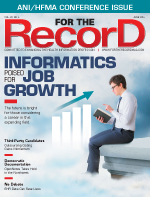June  2016
2016
The Road Ahead for HIT
By Paul Brient
For The Record
Vol. 28 No. 6 P. 5
The health care industry, at long last, has paved the cow paths. Just as legend says there are now roads in downtown Boston that follow trails originally blazed by wandering cattle, so too there are now computers in hospitals doing what physicians, until relatively recently, did on paper. The problem is the work, for the most part, is being done the same way it was done on paper. As a result, health care is failing to use computers to their full potential.
Today's EHR systems are not optimal, but they are a necessary first step toward the ultimate goal of applying computers to measurably improve patient care and outcomes. That is why, regardless of how the federal government's meaningful use program eventually is phased out, EHRs are here to stay, and why they (or their successors) ultimately will be a force for good in health care.
First, some recent history. President Barack Obama signed the HITECH Act into law on February 17, 2009, as part of the ARRA economic stimulus bill. HITECH stipulated that, beginning in 2011, health care providers would be offered financial incentives for demonstrating meaningful use of EHRs until 2015, after which time penalties would be levied for failing to demonstrate such use.
This has been called "the most important piece of health care legislation to be passed in the last 20 to 30 years." While this legislation put a much-needed emphasis on health care—and particularly the role IT should play in it—the reality is we have been left with a promise unfulfilled.
Today, physicians are less productive than they were before—and IT is the culprit. Rather than enabling a better, more streamlined workflow, IT has become a burden. To be clear, physicians are not doing less or more; they're doing the same things and spending more time on them. Physicians often find themselves spending time late at night writing their progress notes or reconciling their patients' medications—tasks that can take up to an hour per patient with many IT systems.
The problem is well recognized, even by the federal agencies that championed EHR adoption. The drag that IT is placing on health care providers is a principal reason why Health and Human Services Secretary Sylvia Burwell announced with great fanfare at the HIMSS16 conference an "interoperability pledge," which vendors and providers alike are encouraged to take. Its purpose in part is "to help consumers easily and securely access their electronic health information, direct it to any desired location, learn how their information can be shared and used, and be assured that this information will be effectively and safely used to benefit their health and that of their community."
This call resonates because the promise of better health care through technology has been broken. Technology has changed the way we communicate, the way we shop, the way we watch TV, the way we drive, and the way we interact with our homes. As an industry, health care is lagging far behind. And the consequences are drastic. In order for us to deliver the kind of holistic care that will truly improve people's health, it's time not only to talk about the potential but also to make it a reality for users and providers across the health care continuum.
The reality is that we have today what 10 years ago was called a supercomputer in front of physicians—a device that knows virtually everything about the patient—but it isn't helping out in ways we take for granted in our everyday lives when we shop online, use Google Maps, or order an Uber.
We had to get to the computer first, through widespread adoption of EHRs. Now that we're here, we have to make the computer an essential tool. It needs to adapt to the way physicians work and seamlessly integrate into their workflow. It should know and suggest things that doctors on their own don't and can't already know.
What a physician understands about a patient's situation—the patient-specific knowledge base upon which his or her clinical diagnosis and treatment plan are structured—is determined by the information that's presented on the EHR screen. This points to another problem. Unlike the world of paper records, with its illegible handwriting and overstuffed files, today's primary obstacles to communication clarity and efficiency are poorly designed data presentation on computer or tablet screens, fragmented information sources, and unwieldy interfaces that require dozens of mouse clicks or screen taps by busy clinicians.
We need to make health care work for both physicians and patients—and leverage the innovative, groundbreaking tools we have at our disposal. IT should enhance, not hinder, the health care experience.
We will start to see a change over the next several years as the HITECH Act-inspired meaningful use program winds down and we are able to get back to innovation focused on streamlining physician workflow and improving patient health at the local level rather than complying with government mandates. I have no doubt that physicians will appreciate and embrace the technological advances that result.
— Paul Brient is CEO of PatientKeeper, Inc.



